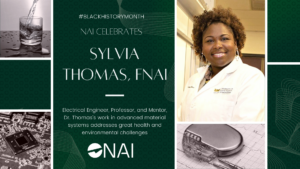Original interview recorded February 16th, 2022.
 “Small town Mississippi girl dreaming of big-time engineering, inspired by my mother, a 30-year educator, and my father, a computer science professor, I embarked upon a life of helping society solve problems through technology and innovation. Looking back on my secondary chemistry, physics and math education and inspirations by Mr. Roach and Ms. McDowell, I remember the formulas, math fundamentals, and the excitement of new discoveries and connecting the dots.
“Small town Mississippi girl dreaming of big-time engineering, inspired by my mother, a 30-year educator, and my father, a computer science professor, I embarked upon a life of helping society solve problems through technology and innovation. Looking back on my secondary chemistry, physics and math education and inspirations by Mr. Roach and Ms. McDowell, I remember the formulas, math fundamentals, and the excitement of new discoveries and connecting the dots.
During the summer of my junior and senior years of high school, I attended an engineering summer experience at Vandy (Vanderbilt University), and this is where it all came full circle – how the math, sciences, and creativity all come together to help me understand the world in which we live – I had been called or summoned to a life of constant technical evolution. I explored every engineering major from electrical to mechanical to civil to engineering management. With a preview of all the different engineering majors I could dive into, I decided on electrical engineering, because I viewed it as the building block for many technologies and engineering fields of study. The struggle was real, i.e. transitioning from high school to college and being away from home. I strapped in and got into study groups, met with my professors, connected with supportive friends (new and old), and successfully graduated with bachelor and masters degrees in EE from Vandy.
Captivated by an ever-changing world, I wanted to put my skills and degree to use and I did for P&G, IBM, and Kimberly Clark, making Pringles potato chips, fixing historic XT computers, and perfecting Huggies diapers. Inspired by my father, the late Dr. Eddie Lee Wilson, I went on to obtain a PhD in electrical engineering from Howard University with a specialization in material science and device fabrication. Strengthened by faith and determination, I secured a position with Lucent Technologies-Bell Labs as a Member of the Technical Staff. It was during this time I realized the importance of patenting your innovations, your work, your contributions. Bells Labs has a history of phenomenal engineers and inventors and I wanted to be a part of that legacy, so it was with Lucent-Bell Labs that I received my first patents supporting device technology.
Fast forward ten years, and I am leading the Advanced Membrane and Materials Bio and Integration Research (AMBIR) lab at the University of South Florida, where I encourage my undergraduate and graduate students to “think outside of the box”, and as I was told, “when in doubt, disclose”. As we went through the ideation, discovery, investigating, and prototyping of new material composites and device development, I tried to convey the bridge between research and innovation/intellectual property created along the journey.
It was even more profound to understand how the innovations can and will impact the quality of life of people. Having family members with diabetes, I was energized to see how my work with device development and advanced materials could make a difference. Therefore, I went to work in collaboration with my students, on developing low cost, low power, miniaturized electronic circuitry and advanced materials with greater longevity and durability to support biosensors for sensing applications, nanomaterials for flexible electronics, and nanostructures for sustainable energy, water, and healthcare systems.
The IP integrates low power systems on a chip, inclusive of a patented mini notched turbine for energy harvesting, making long term continuous power accessible for implantable devices, such as RF sensors, pacemakers, defibrillators, body sensors, etc. Contributions involving an implantable biosensor comprising a silicon carbide substrate to monitor blood glucose levels for diabetic patients further enhanced biosensing technology. Building on this biosensing framework, new designs integrated nanofibers and novel transimpedance amplifier circuitry to address the industry need for cost effective, low noise, and more energy efficient integrated systems for miniaturized ICs for the Internet of Things (IoT), healthcare, environment, and alternative energy.
Remembering my talk at the United Nations-NGO briefing, referencing girls in underdeveloped countries having to miss school to collect water, the BP oil spill, the Flint water crisis, and clean water scarcity, my contributions to sustainability are in the innovative application of cactus biomembranes for water filtration and regenerative disease treatment through skin grafting, tissue scaffolding, and wound healing. The excitement forges on with recent patent(s) and work to address the use in nanoelectronics with a coaxial and triaxial comprising a core and shell(s) of semiconductive organic polymers or bio composite polymers for miniaturization of ICs, drug delivery, wearable/flexible electronics, and healthcare challenges plaguing millions.
There definitely have been challenges along the way, second-guesses as a corporate engineer, questions as an underrepresented minority female engineer, but I couldn’t and wouldn’t let the “nay sayers” or doubters deter me. More importantly as a motivator of young STEM believers, I say, ‘leadership, at any level, is not about what you can take; it’s about what you can give!’
I challenged myself to make a difference. Now I challenge each of you!”